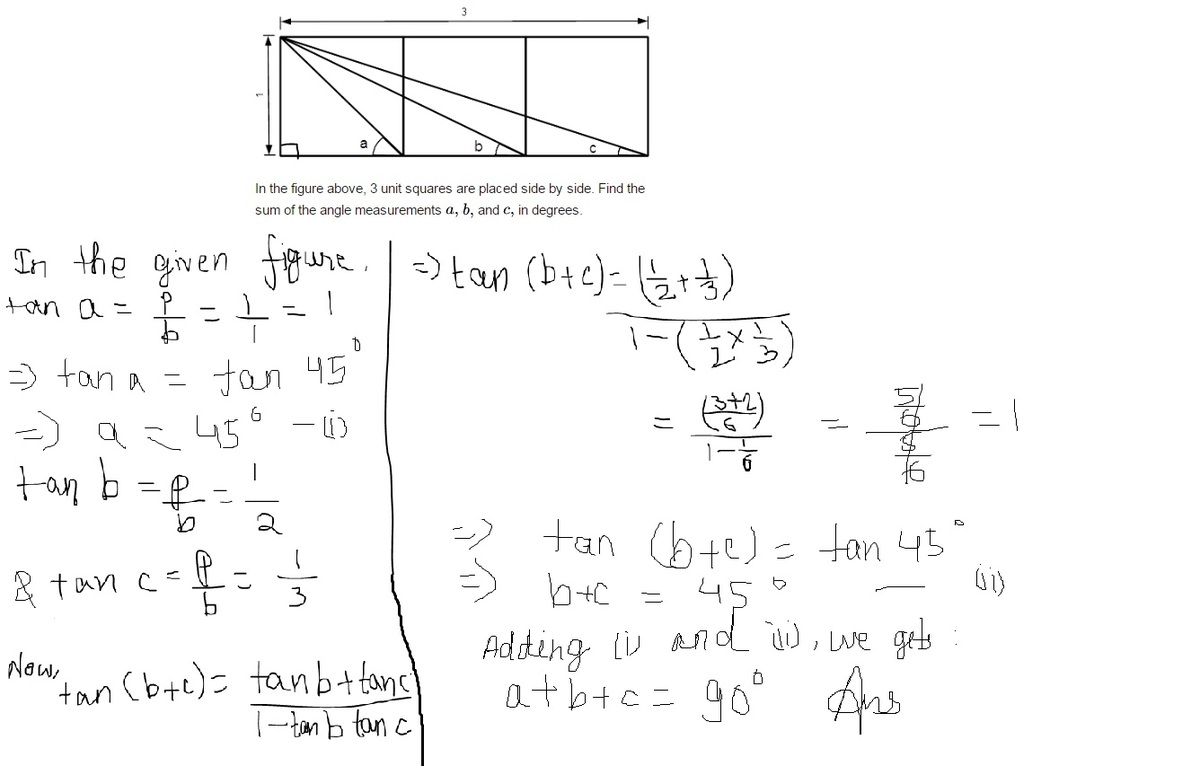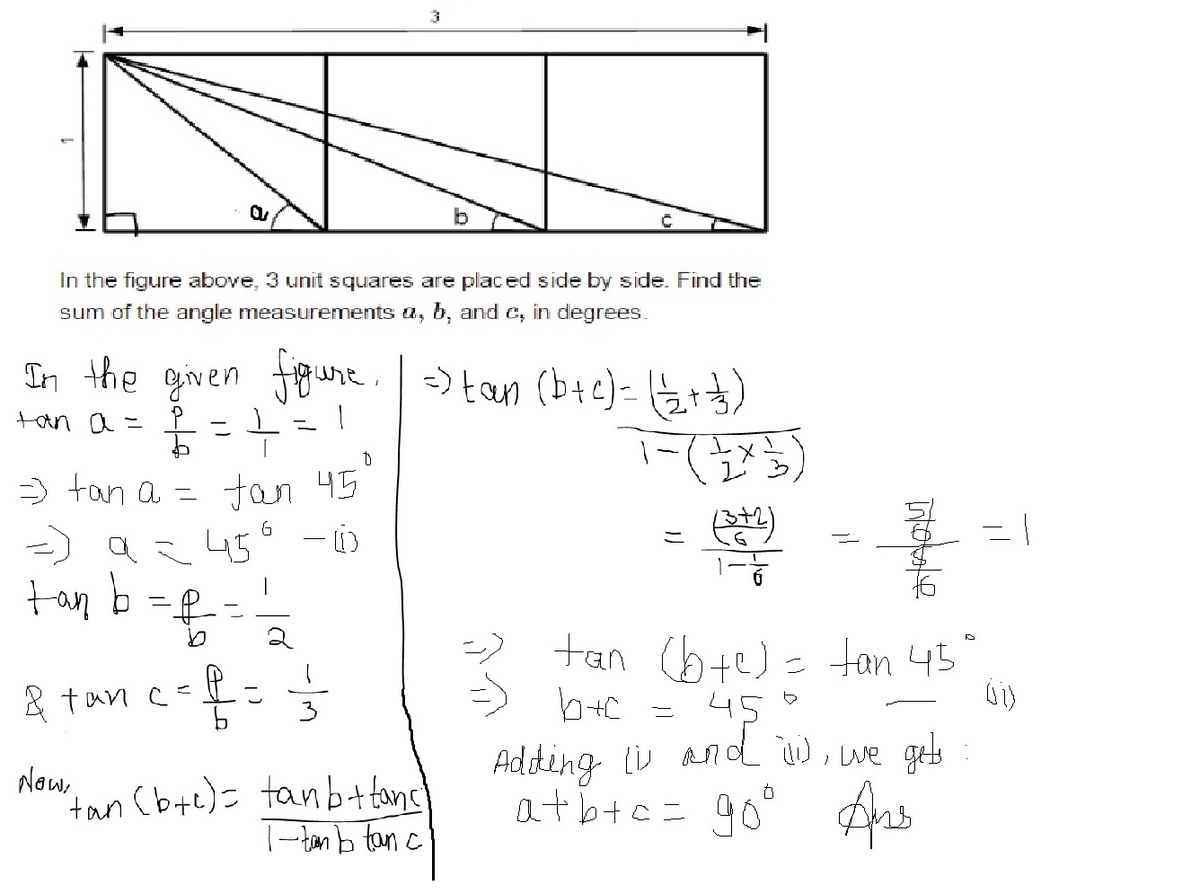3 Squares Puzzle
In the figure above, 3 unit squares are placed side by side. Find the sum of the angle measurements a , b , and c , in degrees.
The answer is 90.
This section requires Javascript.
You are seeing this because something didn't load right. We suggest you, (a) try
refreshing the page, (b) enabling javascript if it is disabled on your browser and,
finally, (c)
loading the
non-javascript version of this page
. We're sorry about the hassle.
12 solutions
beautiful solution!
Log in to reply
that is great thought! but can you enter the dimension of sides of triangles and if possible explain how you have superimposed sides on each other to make it into a sensible figure. GREAT JOB anyways!!!
Log in to reply
The reason I didn't include the dimensions of the triangles is because I didn't want to introduce unnecessary visual clutter. Though having the dimensions on the spot is convenient, they can easily be derived using the grid in the background.
To be honest, this method rarely works. I was just thinking can I do this without calculating since I was pretty lazy on that day. It would be cool if someone could provide a formal proof for whether or not such a figure exists.
Very simple way is
Find it through ratio.
1(45°)+2/3(45°)+1/3(45°)=90°
Log in to reply
with 3:1 ratio of the sides for the triangle with the angle c, 3c+c=90 and thus c=45/2. Cud u please explain how did u get c=45/3. Thanks in advance.
Very elegant!
Extraodinary Explanation
This video describe a similar solution without scale triangles https://www.youtube.com/watch?v=m5evLoL0xwg
i used arctan hahahaha 45 + 27 + 18 = 90 XD
Can you elaborate on the NOTE?
I love a good "proof by picture".
A truly elegant solution
I believe that the answer is 94.47122063
Log in to reply
Mohamed, you are possibly using sin rather than tan in one of your calculations. Sin = Opp/Hyp and Tan = Opp/Adj legs. And that is why you reach 94.47 and not 90 degrees (I had that mix up before).
( i + 1 ) ⋅ ( i + 2 ) ⋅ ( i + 3 ) = 1 0 i which has angle 9 0 .
Lovely solution.
i dont understand, can u explain?
Log in to reply
You can take those angles like complex numbers', so, if you take the three complex numbers x , y , and z such that a r g ( x ) = a , a r g ( y ) = b and a r g ( z ) = c you will find out that x = 1 + i , y = 2 + i and z = 3 + i . For finding the value of a + b + c we can use that x y z = r c i s ( a + b + c ) where r is the module of x y z . As x y z = 1 0 i we have that a + b + c = 2 π or, in degrees, a + b + c = 9 0
Very beautiful solution
On an x y -grid, draw triangle Δ A B C with coordinates A ( 0 , 3 ) , B ( 2 , 2 ) and C ( 1 , 0 ) . Also label the origin O ( 0 , 0 ) and the point D ( 3 , 3 ) .
Then since A B = B C = 5 and A C = 1 0 we have that Δ A B C is a right isosceles triangle, and so ∠ B A C = 4 5 ∘ , which is also the same value as a .
Now ∠ O A C = c and ∠ B A D = b . But ∠ O A C + ∠ B A C + ∠ B A D = 9 0 ∘ , so a + b + c = 9 0 ∘ .
Comment: Note that this can be written as
arctan ( 1 ) + arctan ( 2 1 ) + arctan ( 3 1 ) = 2 π .
Now for x > 0 we have that arctan ( x 1 ) = 2 π − arctan ( x ) , (proof below).
So upon substitution we have that
( 2 π − arctan ( 1 ) ) + ( 2 π − arctan ( 2 ) ) + ( 2 π − arctan ( 3 ) ) = 2 π
⟹ arctan ( 1 ) + arctan ( 2 ) + arctan ( 3 ) = π ,
which is kind of cool. :)
Proof: Let f ( x ) = arctan ( x ) + arctan ( x 1 ) for x > 0 .
Then f ′ ( x ) = 1 + x 2 1 + ( 1 + x 2 1 1 ) ∗ ( − x 2 1 ) = 1 + x 2 1 − 1 + x 2 1 = 0 .
Thus f ( x ) must equal some constant for x > 0 . So plug in any positive value for x to find out what this constant is. We have f ( 1 ) = 4 π + 4 π = 2 π , and so arctan ( x 1 ) = 2 π − arctan ( x ) for x > 0 .
(Note that for x < 0 we would have f ( x ) = − 2 π , so the formula for x < 0 would be arctan ( x 1 ) = − 2 π − arctan ( x ) .)
Sir can u please send me your facebook id so that i can add you to my friends list.
This is the real solution. Thanks
tan -1 x + tan -1 y= tan -1 (x+ y)/(1-xy)
Now tan a = 1, tan b = 1/2 and tan c = 1/3
Now a + b +c = tan -1 ( 1) + tan-1 (1/2) + tan -1(1/3) =45 + tan-1 (( 1/2 +1/3)/(1-(1/2)x(1/3))) = 45 + tan-1(1)= 45+45= 90 degrees
im almost there i solve it almost like that and get 89
I support it . :)
very nice soloution
how did you get the tan values? Now tan a = 1, tan b = 1/2 and tan c = 1/3
Solve in the same manner. Straight forward . Nice one Nidhin
tan (b+c) = (tan (b) + tan (c)) / (1-tan (b)*tan(c))
= (1/2 + 1/3) / (1 - (1/2)*(1/3))
= (5/6) / (1 - 1/6)
= (5/6)/(5/6)
= 1
Hence, (b+c) = 45 and (a+b+c) = 90
I like this solution. Haha, but I use calculator
Exactly what I was looking for, instead of inverse trigonometric ratios! Thank you!
The first box is a square. Therefore, the triangle formed out of it is isosceles. hence each of the other opposite angle = 45 degrees. hence angle a = 45. Angle b = 30 Angle c = 15 a+b+C = 45+30+15 = 90
That's not actually the case. Using trigonometry, we have that
b = arctan ( 2 1 ) = 2 6 . 5 6 5 ∘ and c = arctan ( 3 1 ) = 1 8 . 4 3 5 ∘ ,
each to 3 decimal places. These also add to 4 5 ∘ , but individually are different than the values you give.
P.S.. Welcome to Brilliant. Sorry I had to start out by disagreeing with you. :(
Log in to reply
without calculataor
Log in to reply
I know that. Check out my solution; it requires nothing more than the Pythagorean Theorem. I was simply pointing out to Veena that her solution method was flawed in that the angle values she quoted for b and c were not correct, even though they happened to add to 45 degrees.
This solution is completely false , because you say that tan(b)=sin(b) ,which cannot be true in right-angled triangle.
Log in to reply
yes tan(b)=sin(b) can true when b is very very small. It means when b tends to zero only then the relation can be true. But it is not true for this case as the angles are not tends to zero.
This problem was actually on one Numberphile video (The Three Square Geometry Problem).You can watch it if you like.
Why are b and c 30 and 15?
how can you know angle b and c measures 30 and 15 respectively
Log in to reply
read the above post and you need a bit of trigonometrical ratios and it's knowledge
According to your solution arctan(1/2)=arctan(1/root3) and finally 1/2= 1/root3. But this is not true.
Nice solution mam.
thts wrong logic ( even i didnt get the amnswer to this question )
no,you are wrong. According to you b=30 and if we see in the figure tan(b)=1/2 but tan(30)=1/(3^1/2)
a=45 tatz fyn/......hw come yu say b= 30???& c= 15???? can yu please explain??
How b=30 and c=15
 The solution is based on trigonometry
The solution is based on trigonometry
arctan(1)+arctan(1/2)+arctan(1/3) = 90d
a is obviously 4 5 ° , b = arccos ( 5 2 ) = arcsin ( 5 1 ) , c = arccos ( 1 0 3 ) = arcsin ( 1 0 1 ) . But cos ( b + c ) = cos b ⋅ cos c − sin b ⋅ sin c = 2 2 so a + b + c = 9 0 °
When read your solutions I feel stupid haha. I don't know if it is right but I just divided 45 by 3 and it gives me 15, then: 45, 30, 15. And its sum is 90 haha.
Moderator note:
It is not true that b = 3 0 ∘ and c = 1 5 ∘ . In fact, it should be slightly surprising that the sum is indeed 9 0 ∘ .
I have seen this type of question first time andI solved this by only watching the question

Since scaling, translating, reflecting, and rotating do not change the triangles' angles, we can reorganize them like so. The sum of the angles becomes trivial.
Note: I scaled the right triangles with angle a , b , and c by 2 , 2 , and 1 respectively.